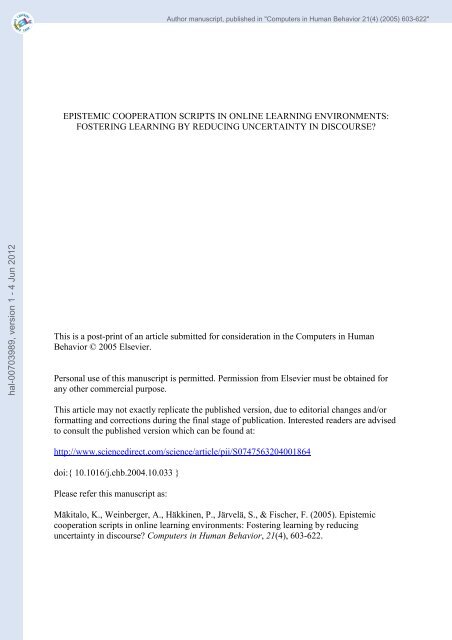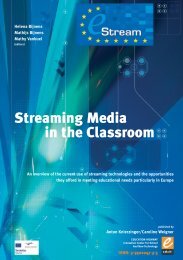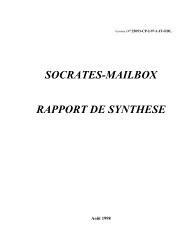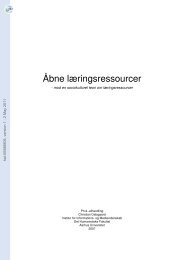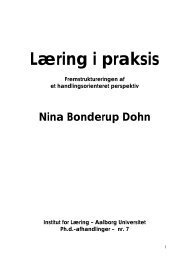Epistemic cooperation scripts in online learning environments ...
Epistemic cooperation scripts in online learning environments ...
Epistemic cooperation scripts in online learning environments ...
You also want an ePaper? Increase the reach of your titles
YUMPU automatically turns print PDFs into web optimized ePapers that Google loves.
<strong>Epistemic</strong> <strong>cooperation</strong> <strong>scripts</strong> 4<strong>Epistemic</strong> Cooperation Scripts <strong>in</strong> Onl<strong>in</strong>e Learn<strong>in</strong>g Environments: Foster<strong>in</strong>g Learn<strong>in</strong>g byReduc<strong>in</strong>g Uncerta<strong>in</strong>ty <strong>in</strong> Discourse?Onl<strong>in</strong>e learn<strong>in</strong>g <strong>environments</strong> can, for example, enhance collaborative learn<strong>in</strong>g <strong>in</strong>higher education by provid<strong>in</strong>g shared workspaces <strong>in</strong> which learners can work together onauthentic problem cases (e.g., Strijbos, Kirschner, & Martens, 2004). However, onl<strong>in</strong>elearn<strong>in</strong>g <strong>environments</strong> do not guarantee that learners will <strong>in</strong>teract with each other (Kreijns,Kirschner, & Jochems, 2003). People participat<strong>in</strong>g <strong>in</strong> onl<strong>in</strong>e learn<strong>in</strong>g courses often do notknow each other and are unsure how to act <strong>in</strong> these learn<strong>in</strong>g <strong>environments</strong>. In <strong>in</strong>itialhal-00703989, version 1 - 4 Jun 2012<strong>in</strong>teraction situations there is some degree of uncerta<strong>in</strong>ty (Berger & Bradac, 1985; Berger &Calabrese, 1975), and onl<strong>in</strong>e, often physically distanced learn<strong>in</strong>g <strong>environments</strong> lackimmediate feedback and non-verbal cues, which might further <strong>in</strong>crease uncerta<strong>in</strong>ty (e.g.,Järvelä & Häkk<strong>in</strong>en, 2002; Roschelle & Pea, 1999).Uncerta<strong>in</strong>ty can appear at two different levels: at the socio-emotional level and at theepistemic level (Mäkitalo, Pöysä, & Häkk<strong>in</strong>en, 2003). At the socio-emotional leveluncerta<strong>in</strong>ty can occur, for example, when participants do not get immediate feedback on howothers are react<strong>in</strong>g to their messages, whether they agree or disagree with one’s suggestionsand how they will organize their jo<strong>in</strong>t work. At the epistemic level, participants may beuncerta<strong>in</strong> about the content-wise quality of their contributions: Are their contributionsrelevant regard<strong>in</strong>g the issue? Do the learn<strong>in</strong>g partners understand the content of the message(see Beers, Boshuizen, Kirschner, & Gijselaers, this issue)? Due to the novelty and thecomplexity of its social context, onl<strong>in</strong>e collaborative learn<strong>in</strong>g courses can be regarded as ahighly uncerta<strong>in</strong> form of communication, <strong>in</strong> which learners may need additional support toreduce uncerta<strong>in</strong>ty.
<strong>Epistemic</strong> <strong>cooperation</strong> <strong>scripts</strong> 5One of the goals of the research presented here is to <strong>in</strong>vestigate discourses of onl<strong>in</strong>elearn<strong>in</strong>g <strong>environments</strong> with the help of the uncerta<strong>in</strong>ty reduction theory (Berger & Bradac,1985). This theory suggests that a high degree of uncerta<strong>in</strong>ty may h<strong>in</strong>der participants fromeffectively communicat<strong>in</strong>g with each other with respect to atta<strong>in</strong><strong>in</strong>g shared goals (e.g., solv<strong>in</strong>ga problem together). In communication science, Berger and his colleagues (Berger & Bradac,1985; Berger & Calabrese, 1975) have developed the uncerta<strong>in</strong>ty reduction theory, seek<strong>in</strong>g toexpla<strong>in</strong> how uncerta<strong>in</strong>ty affects communication. Orig<strong>in</strong>ally, this theory was not related toonl<strong>in</strong>e learn<strong>in</strong>g. The important components of this theory, which we are apply<strong>in</strong>g here tohal-00703989, version 1 - 4 Jun 2012onl<strong>in</strong>e learn<strong>in</strong>g, are uncerta<strong>in</strong>ty, amount of discourse, and <strong>in</strong>formation seek<strong>in</strong>g. Berger and hiscolleagues show that as the amount of verbal communication <strong>in</strong> <strong>in</strong>itial <strong>in</strong>teraction situations<strong>in</strong>creases, the level of uncerta<strong>in</strong>ty decreases. Furthermore, as uncerta<strong>in</strong>ty is reduced, theamount of verbal communication <strong>in</strong>creases. They also po<strong>in</strong>t out that <strong>in</strong>formation-seek<strong>in</strong>gbehavior is <strong>in</strong>creased <strong>in</strong> uncerta<strong>in</strong> situations. As uncerta<strong>in</strong>ty is reduced, <strong>in</strong>formation-seek<strong>in</strong>gbehavior decreases (Berger & Bradac, 1985; Berger & Calabrese, 1975). Therefore,uncerta<strong>in</strong>ty may <strong>in</strong>fluence onl<strong>in</strong>e discourse. However, the relationship between uncerta<strong>in</strong>tyand uncerta<strong>in</strong>ty reduction activities (e.g., <strong>in</strong>formation seek<strong>in</strong>g), with learn<strong>in</strong>g outcomes hasnot yet been systematically <strong>in</strong>vestigated.In collaborative learn<strong>in</strong>g <strong>environments</strong>, specific forms of discourse are consideredimportant for learn<strong>in</strong>g. The k<strong>in</strong>d of discourse <strong>in</strong> which participants ask certa<strong>in</strong> types ofquestions, evaluate suggestions, elaborate explanations and justifications, hypothesize andsummarize the ongo<strong>in</strong>g discourse, seems to be especially effective for learn<strong>in</strong>g <strong>in</strong>collaborative situations (K<strong>in</strong>g, 1999; Webb, 1989). Information seek<strong>in</strong>g itself does notnecessarily foster collaborative learn<strong>in</strong>g, but it can be seen as a mediator to learn<strong>in</strong>gprocesses, from comprehension to knowledge construction (K<strong>in</strong>g, 1999). Accord<strong>in</strong>g to K<strong>in</strong>g
<strong>Epistemic</strong> <strong>cooperation</strong> <strong>scripts</strong> 6(1999), open-ended and thought-provok<strong>in</strong>g questions enhance the discourse, because theyprovoke explanations and reasons. Elaborat<strong>in</strong>g explanations to learn<strong>in</strong>g partners is a goodpredictor of responder’s achievement (Webb, 1989). K<strong>in</strong>g (1999) po<strong>in</strong>ts out thatcomprehension questions are not very thought provok<strong>in</strong>g, because they are memory-basedand ask learners only for recall of the presented material. Respond<strong>in</strong>g to comprehensionquestions requires a learn<strong>in</strong>g partner to reformulate def<strong>in</strong>itions and descriptions byparaphras<strong>in</strong>g them <strong>in</strong> their own words, which enhances the responder’s own th<strong>in</strong>k<strong>in</strong>g andlearn<strong>in</strong>g. On the other hand, learn<strong>in</strong>g takes place when the <strong>in</strong>formation seeker receives thehal-00703989, version 1 - 4 Jun 2012relevant help and understands it and has an opportunity to elaborate the received <strong>in</strong>formation(Webb, 1989). The discourse pattern which <strong>in</strong>cludes <strong>in</strong>formation seek<strong>in</strong>g, respond<strong>in</strong>g to<strong>in</strong>formation seek<strong>in</strong>g and receiv<strong>in</strong>g requested <strong>in</strong>formation, is seen as an important process forcollaborative learn<strong>in</strong>g (K<strong>in</strong>g, 1999; Webb, 1989).The activities of collaborative learn<strong>in</strong>g, such as knowledge articulation, explanations,argumentation and other demand<strong>in</strong>g epistemic activities can be supported <strong>in</strong> different ways bycommunication tools and shared workspaces <strong>in</strong> onl<strong>in</strong>e learn<strong>in</strong>g <strong>environments</strong> (e.g., Häkk<strong>in</strong>en,Arvaja, & Mäkitalo, 2004; Strijbos et al., 2004). One of the recent approaches to facilitateonl<strong>in</strong>e collaborative learn<strong>in</strong>g at the process level is to provide learners with <strong>cooperation</strong><strong>scripts</strong> that specify and sequence their collaborative learn<strong>in</strong>g activities (Dillenbourg, 2002;Kollar, Fischer, & Hesse, 2003; We<strong>in</strong>berger, 2003). Cooperation <strong>scripts</strong> (i.e., a set of rulesthat prescribe the way learners should <strong>in</strong>teract with each other and collaboratively work on atask) have been found to facilitate collaborative learn<strong>in</strong>g activities <strong>in</strong> face-to-face learn<strong>in</strong>g<strong>environments</strong> (O’Donnell, 1999). Prior to collaborative learn<strong>in</strong>g, learners are verbally<strong>in</strong>structed to engage <strong>in</strong> specified activities at certa<strong>in</strong> times. In the context of onl<strong>in</strong>ecollaborative learn<strong>in</strong>g, the script is represented by the <strong>in</strong>terface design <strong>in</strong>stead of verbal
<strong>Epistemic</strong> <strong>cooperation</strong> <strong>scripts</strong> 7<strong>in</strong>structions and tra<strong>in</strong><strong>in</strong>g. The <strong>in</strong>terface specifies and sequences activities dur<strong>in</strong>g the actualcollaborative learn<strong>in</strong>g phase, for <strong>in</strong>stance, by prompt<strong>in</strong>g learners to answer specific questions(We<strong>in</strong>berger, 2003). Beers, Boshuizen, Kirschner and Gijselaers (this issue) present anexample of a tool, which <strong>scripts</strong> onl<strong>in</strong>e negotiation of mean<strong>in</strong>g.Typically, <strong>scripts</strong> give a complex set of <strong>in</strong>structions to collaborative learners withrespect to several goal dimensions. The prototypical script of O’Donnell and Dansereau(1992), for <strong>in</strong>stance, supports meta-cognitive and elaborative activities of collaborativelearners. This script for text comprehension asks learners to read through paragraphs, repeathal-00703989, version 1 - 4 Jun 2012them <strong>in</strong> their own words, mutually monitor these summarizations for mistakes, and elaboratethe given text. Scripts may also aim at specific process dimensions of collaborative learn<strong>in</strong>g,for example, to particularly support epistemic activities. An epistemic <strong>cooperation</strong> script aimsto facilitate cognitive processes by provid<strong>in</strong>g collaborative learners with a strategy to solve atask. On one hand, epistemic <strong>scripts</strong> may enhance collaborative activities such as expla<strong>in</strong><strong>in</strong>g(Coleman, 1998), question<strong>in</strong>g (e.g., Ge & Land, 2002; Hron, Hesse, Cress, & Giovis, 2000),and expert-like problem-solv<strong>in</strong>g behavior (Dufresne, Gerace, Thibodeau Hardiman, &Mestre, 1992). On the other hand, epistemic <strong>scripts</strong> may disturb epistemic activities if the<strong>scripts</strong> are too detailed (Baker & Lund, 1997; Dillenbourg, 2002) if they underestimate expertlearners’ capabilities (Cohen, 1994; Salomon & Globerson, 1989), or if they overrate novicelearners’ resources (Dansereau, 1988). One of the major questions <strong>in</strong> this field is to whatextent <strong>in</strong>teraction should be structured on an epistemic level <strong>in</strong> order to support the waylearners cope with the uncerta<strong>in</strong> situation of onl<strong>in</strong>e learn<strong>in</strong>g.Aim of this Study
<strong>Epistemic</strong> <strong>cooperation</strong> <strong>scripts</strong> 8The aim of this study was to <strong>in</strong>vestigate the effects of an epistemic <strong>cooperation</strong> script onthe amount of discourse, <strong>in</strong>formation seek<strong>in</strong>g and <strong>in</strong>dividual learn<strong>in</strong>g outcomes <strong>in</strong>collaborative learn<strong>in</strong>g. More specifically, the follow<strong>in</strong>g research questions were addressed:Research question 1: What effects does an epistemic script have on the amount of discourse <strong>in</strong>collaborative learn<strong>in</strong>g compared to unscripted collaborative learn<strong>in</strong>g?Based on the uncerta<strong>in</strong>ty reduction theory the follow<strong>in</strong>g hypothesis was formulated.Hypothesis 1: The epistemic script will <strong>in</strong>crease the amount of discourse. Based on theuncerta<strong>in</strong>ty reduction theory, we assume that it may be possible to reduce uncerta<strong>in</strong>ty byhal-00703989, version 1 - 4 Jun 2012provid<strong>in</strong>g a specific task strategy with an epistemic script. Therefore, we expected that theepistemic script would <strong>in</strong>crease the amount of discourse.Research question 2: What effects does an epistemic script have on the amount of <strong>in</strong>formationseek<strong>in</strong>g <strong>in</strong> collaborative learn<strong>in</strong>g compared to unscripted collaborative learn<strong>in</strong>g?Hypothesis 2: The epistemic script will reduce <strong>in</strong>formation seek<strong>in</strong>g. Accord<strong>in</strong>g to theuncerta<strong>in</strong>ty reduction theory, low uncerta<strong>in</strong>ty decreases <strong>in</strong>formation seek<strong>in</strong>g. The theory alsopredicts that <strong>in</strong> highly uncerta<strong>in</strong> situations participants seek more <strong>in</strong>formation. As theepistemic script is expected to reduce uncerta<strong>in</strong>ty, we assumed that the epistemic script wouldalso lessen <strong>in</strong>formation seek<strong>in</strong>g.Research question 3: What effects do epistemic <strong>scripts</strong> <strong>in</strong> collaborative learn<strong>in</strong>g have on<strong>in</strong>dividual learn<strong>in</strong>g outcomes <strong>in</strong> comparison to unscripted collaborative learn<strong>in</strong>g?So far, the uncerta<strong>in</strong>ty reduction theory does not provide a basis for hypotheses on howuncerta<strong>in</strong>ty may be related to <strong>in</strong>dividual learn<strong>in</strong>g outcomes. Therefore, we formulate thefollow<strong>in</strong>g explorative research questions that will be addressed us<strong>in</strong>g a qualitative approach.Research question 4: How and what k<strong>in</strong>d of <strong>in</strong>formation do learners seek?Research question 5: How do learn<strong>in</strong>g partners react to <strong>in</strong>formation seek<strong>in</strong>g?
<strong>Epistemic</strong> <strong>cooperation</strong> <strong>scripts</strong> 11The onl<strong>in</strong>e learn<strong>in</strong>g environment can be used via the World Wide Web (WWW), and itis built on standard html-format web-pages. The environment is a password protected website<strong>in</strong> which three learners can post messages (see Figure 3). In the upper left corner of the screenlearners f<strong>in</strong>d a task description and a timer, which can be modified and adapted to differentsett<strong>in</strong>gs of the learn<strong>in</strong>g <strong>environments</strong>.-----------------------Insert Figure 3 here-----------------------hal-00703989, version 1 - 4 Jun 2012In the lower left corner there is a map of the three discussion boards, which shouldfacilitate orientation. The current discussion board is marked with a red X. On the screen,there is also a description of the problem cases. Below the case <strong>in</strong>formation a text messagecan be typed <strong>in</strong> text w<strong>in</strong>dows. In the epistemic script condition the text w<strong>in</strong>dows of <strong>in</strong>itialmessages are pre-structured with prompts, to which learners are supposed to react (see Figure3). After learners have sent <strong>in</strong> their contributions they can access an overview page of the<strong>in</strong>dividual onl<strong>in</strong>e discussion boards. Discussions form a threaded structure <strong>in</strong> the overviewpage, which is typical for standard discussion boards.Data Sources and InstrumentsThe written discussion data consisted of 16 group discussions (<strong>in</strong>clud<strong>in</strong>g three problemsolv<strong>in</strong>g cases) from eight groups <strong>in</strong> two different conditions. We approached the data bothquantitatively and qualitatively. Both quantitative and qualitative approaches as well astheory-based and data-driven approaches may complement each other (Häkk<strong>in</strong>en, Järvelä, &Mäkitalo, 2003). The use of different methods allows the researcher to exam<strong>in</strong>e differentfacets of a phenomenon <strong>in</strong> a more holistic way (Tashakkori & Teddlie, 1998). The data wasaggregated and analyzed at the group level.
<strong>Epistemic</strong> <strong>cooperation</strong> <strong>scripts</strong> 12First, we segmented the discourse corpora <strong>in</strong>to propositions. Agreement between twocoders <strong>in</strong> identify<strong>in</strong>g these units of analysis was acceptable (Κ=.72). In the quantitativeprocedure we used word counts of all messages with<strong>in</strong> groups <strong>in</strong> order to measure the amountof discourse. Information seek<strong>in</strong>g was analyzed with the help of the social modes of coconstructiondimension <strong>in</strong> the “Cod<strong>in</strong>g system of a multi-level analysis of knowledge coconstruction”(We<strong>in</strong>berger, Fischer, & Mandl, 2002; Κ=.81). If a learner aimed to get aresponse from the learn<strong>in</strong>g partners, this attempt was classified as <strong>in</strong>formation seek<strong>in</strong>g. This istypically done by ask<strong>in</strong>g questions, for example, “What do you mean by that?”hal-00703989, version 1 - 4 Jun 2012The post-test based on a problem case measured <strong>in</strong>dividual learn<strong>in</strong>g outcomes. Theproblem case <strong>in</strong>volved a university student who failed a course, a first for him and expla<strong>in</strong>edhis poor performance as be<strong>in</strong>g related to a lack of talent, while 50 % of the students alsofailed that same course. Students were given 10 m<strong>in</strong>utes to analyze the problem case withoutWe<strong>in</strong>er’s theoretical text. Several concepts of attribution theory were needed to solve the<strong>in</strong>dividual problem cases. Applicable knowledge was measured on the basis of the amount ofadequate relations between theoretical concepts and case <strong>in</strong>formation <strong>in</strong> the solution. Therelations made between theoretical concepts and case <strong>in</strong>formation were identified as adequatewith respect to the theoretical text and an expert solution. Six central relations betweentheoretical concepts and case <strong>in</strong>formation were identified for the students’ post-test analyses.These six central relations were (1) A failure precedes the attribution, (2) “A lack of talent” isan <strong>in</strong>ternal attribution, (3) “A lack of talent” is a stable attribution, (4) “A lack of talent” is anattribution on ability, (5) “Talent” equals ability and, (6) “50% failures” can be attributed totask difficulty. The effects of the epistemic script on the amount of discourse, <strong>in</strong>formationseek<strong>in</strong>g and <strong>in</strong>dividual learn<strong>in</strong>g outcomes were tested for statistical significance with a t testfor unpaired samples. The α-level was set to 5% for every t test.
<strong>Epistemic</strong> <strong>cooperation</strong> <strong>scripts</strong> 13We also studied the ongo<strong>in</strong>g discourse with the help of case-based analyses. Two casebasedanalyses from different conditions were chosen for more detailed qualitative analysis.The discourses were translated from German to English, and the written mistakes and formatwere kept as similar as possible <strong>in</strong> comparison to the orig<strong>in</strong>al discourse.The qualitative analysis was partly theory driven (Berger & Bradac, 1985; Berger &Calabrese, 1975; K<strong>in</strong>g, 1999; Webb, 1989) and partly data driven. We narrowed our focus ofthe qualitative analyses of both case-based analyses to <strong>in</strong>formation seek<strong>in</strong>g processes only.The <strong>in</strong>formation seek<strong>in</strong>g units were identified by quantitative analysis, while the qualitativehal-00703989, version 1 - 4 Jun 2012content analysis was completed <strong>in</strong> explor<strong>in</strong>g both the way learners seek <strong>in</strong>formation and thetype of <strong>in</strong>formation they seek. We also <strong>in</strong>vestigated the way <strong>in</strong> which the learn<strong>in</strong>g partnersreact to <strong>in</strong>formation seek<strong>in</strong>g and how <strong>in</strong>formation seekers react to the received <strong>in</strong>formation.This approach preserves the group as the primary unit of analysis (Barron, 2003). By focus<strong>in</strong>gon the group, we explored <strong>in</strong>teraction that captures the dynamic <strong>in</strong>terplay of <strong>in</strong>formationseek<strong>in</strong>gdiscourse between the participants and the types of contributions they make. At thefirst round, we found out four different <strong>in</strong>formation seek<strong>in</strong>g types: seek<strong>in</strong>g (1) facts (e.g.,“Where does the <strong>in</strong>formation <strong>in</strong> the newspaper come from?”), (2) ideas (e.g., “Do you have anidea here?”), (3) op<strong>in</strong>ions (e.g., “Do you th<strong>in</strong>k that this is part of it?”), and (4) verifications(e.g., “But isn’t it actually about the laz<strong>in</strong>ess of the boy?”). Further, we identified twodifferent ways to seek <strong>in</strong>formation. The direct way for seek<strong>in</strong>g <strong>in</strong>formation was ask<strong>in</strong>gquestions (e.g., “What do you mean by that?”). Participants also used <strong>in</strong>direct <strong>in</strong>formationseek<strong>in</strong>g and they did it mostly by isolated question marks (e.g., “????”) or claims followed bya question mark <strong>in</strong> brackets (e.g., “Stable. (?)”). Two types of reactions were def<strong>in</strong>ed,response (a reply) and no response (no reply) at all. F<strong>in</strong>ally, the analysis focused on the
<strong>Epistemic</strong> <strong>cooperation</strong> <strong>scripts</strong> 14response to received <strong>in</strong>formation, if <strong>in</strong>formation seekers elaborated on the offered<strong>in</strong>formation.ResultsIn this section, the quantitative results will be presented. Subsequently, the case-basedanalyses will be portrayed.The Amount of Discourse, Information Seek<strong>in</strong>g and Individual Learn<strong>in</strong>g OutcomesOur first research question was to study the effects an epistemic script has on theamount of discourse <strong>in</strong> collaborative learn<strong>in</strong>g compared to unscripted collaborative learn<strong>in</strong>g.hal-00703989, version 1 - 4 Jun 2012The amount of discourse was higher <strong>in</strong> the epistemic script condition than <strong>in</strong> the unscriptedcondition (see Table 1). A t-test revealed a significant effect for the epistemic script,t(15) = -2.67, p < .05 (one-tailed). As expected, the epistemic script <strong>in</strong>creased the amount ofdiscourse.-----------------------Insert Table 1 here-----------------------The second research question was to study the effects that an epistemic script has on<strong>in</strong>formation seek<strong>in</strong>g <strong>in</strong> collaborative learn<strong>in</strong>g <strong>in</strong> comparison to unscripted collaborativelearn<strong>in</strong>g. The results show that learners sought <strong>in</strong>formation <strong>in</strong> the epistemic script conditionless often than <strong>in</strong> the unscripted condition (see Table 1). A t-test revealed a marg<strong>in</strong>allysignificant effect of the epistemic script, t(15) = 1.57, p < .10 (one-tailed). These results onlypartly support the hypothesis that the <strong>in</strong>formation seek<strong>in</strong>g scores should be lower <strong>in</strong> theepistemic script condition, and such f<strong>in</strong>d<strong>in</strong>gs should be <strong>in</strong>terpreted with caution.F<strong>in</strong>ally, the results show that <strong>in</strong>dividual learn<strong>in</strong>g outcomes were higher <strong>in</strong> the unscriptedcondition than <strong>in</strong> the epistemic script condition (Figure 4). There were significant differences
<strong>Epistemic</strong> <strong>cooperation</strong> <strong>scripts</strong> 15between the learn<strong>in</strong>g outcomes <strong>in</strong> the unscripted condition <strong>in</strong> comparison with the epistemicscript condition, t(15) = 2.50, p < .05 (two-tailed).-----------------------Insert Figure 4 here-----------------------Case-based Analyses on Information Seek<strong>in</strong>gTwo case-based analyses were conducted to further explore the relation of <strong>in</strong>formationhal-00703989, version 1 - 4 Jun 2012seek<strong>in</strong>g and learn<strong>in</strong>g. The qualitative analysis focused on explor<strong>in</strong>g how and what k<strong>in</strong>d of<strong>in</strong>formation learners seek and how learn<strong>in</strong>g partners react to the <strong>in</strong>formation seek<strong>in</strong>g and thereceived <strong>in</strong>formation. The selection of these two cases (one of each condition) is based on thequantitative results with respect to the amount of discourse, <strong>in</strong>formation seek<strong>in</strong>g and<strong>in</strong>dividual learn<strong>in</strong>g outcomes. The epistemic script group of three students represents a typicalcase with a high amount of discourse (number of words), but low <strong>in</strong>dividual learn<strong>in</strong>goutcomes. The unscripted group of three students was selected for its high level of<strong>in</strong>formation seek<strong>in</strong>g and high <strong>in</strong>dividual learn<strong>in</strong>g outcomes.Every excerpt is accompanied by <strong>in</strong>formation perta<strong>in</strong><strong>in</strong>g to which of these threeproblem cases were <strong>in</strong>volved, the order number of the message, the time the message wassent, and who sent it (see Figure 5; explanation is <strong>in</strong> italics). A previous message, when<strong>in</strong>cluded <strong>in</strong> the new message by the sender, is marked with a ‘>’ at the beg<strong>in</strong>n<strong>in</strong>g of thesentence. Orig<strong>in</strong>al and new messages have no marks, except for the l<strong>in</strong>e numbers. Theprompts <strong>in</strong>cluded <strong>in</strong> epistemic script conditions are shown <strong>in</strong> capital letters.------------------------Insert Figure 5 here
<strong>Epistemic</strong> <strong>cooperation</strong> <strong>scripts</strong> 16-----------------------The sentences that are referred to <strong>in</strong> the analyses are marked <strong>in</strong> italics <strong>in</strong> the excerpts. Inorder to improve readability, the messages are also cut short, which is marked with three dots.Unscripted group. This group sent 88 messages dur<strong>in</strong>g the conference <strong>in</strong> three differentonl<strong>in</strong>e case boards. In the Math case board there was a total amount of 46 messages, <strong>in</strong> theClass case board 29 and <strong>in</strong> the Asian case board 13 messages. The unscripted group started towork at 14:53, and the first message was sent to the Math board after 11 m<strong>in</strong>utes from thestart. The last message was sent to the Class case board at 15:13.hal-00703989, version 1 - 4 Jun 2012In the unscripted group, the members sought <strong>in</strong>formation by us<strong>in</strong>g questions. Thequestions focused on seek<strong>in</strong>g ideas (see Excerpt 1, l<strong>in</strong>e 1) and verifications (Excerpt 2, l<strong>in</strong>e 4).In Excerpt 1, Birgit po<strong>in</strong>ted out that time was runn<strong>in</strong>g short, and she requested that thelearn<strong>in</strong>g partners explore some new ideas to solve and complete the math case.Excerpt 1. M33; 14:22:13; Birgit1. (Half the time is nearly gone!) Can you th<strong>in</strong>k of anyth<strong>in</strong>g else about this analysis?...There were also questions focus<strong>in</strong>g on verify<strong>in</strong>g def<strong>in</strong>itions (see Excerpt 2, l<strong>in</strong>e 4). Thisparticular discussion thread (<strong>in</strong>cludes Excerpts 2-6) presents how one of the learn<strong>in</strong>g partnerswas seek<strong>in</strong>g verification (Excerpt 2, l<strong>in</strong>e 4), how the other learn<strong>in</strong>g partner was respond<strong>in</strong>g to<strong>in</strong>formation seek<strong>in</strong>g (Excerpt 3, l<strong>in</strong>es 1-2) and how the <strong>in</strong>formation seeker was react<strong>in</strong>g to thereceived <strong>in</strong>formation (Excerpt 4, l<strong>in</strong>e 1). This example also shows how the learn<strong>in</strong>g partnerhad offered the <strong>in</strong>formation reacted the <strong>in</strong>formation seeker’s response (Excerpt 5, l<strong>in</strong>e 1) andhow the third learn<strong>in</strong>g partner was also jo<strong>in</strong><strong>in</strong>g <strong>in</strong>to the discourse by elaborat<strong>in</strong>g the offered<strong>in</strong>formation (Excerpt 6, l<strong>in</strong>e 1). The participants were discuss<strong>in</strong>g the <strong>in</strong>ternal stable
<strong>Epistemic</strong> <strong>cooperation</strong> <strong>scripts</strong> 17attribution. Maria doubted (see l<strong>in</strong>e 3-4) that one could diagnose an <strong>in</strong>ternal stable attribution<strong>in</strong> this case and she wanted to verify def<strong>in</strong>itions and see if Stefanie shared her po<strong>in</strong>t of view(see l<strong>in</strong>es 1-2).Excerpt 2. M23; 14:04:13; Maria…1.>So Michael gives a reason for his bad math by an <strong>in</strong>ternal, stable attribution, so he is2.>just not as able as his parents.hal-00703989, version 1 - 4 Jun 20123. I th<strong>in</strong>k that Michael doesn’t blame himself, but his <strong>in</strong>herited genes.4. Can you really label this as an <strong>in</strong>ternal stable attribution?In her reply, Stefanie backed up her earlier statement and expla<strong>in</strong>ed the reason why itcan be seen as an <strong>in</strong>ternal stable attribution (see Excerpt 3, l<strong>in</strong>es 1-2).Excerpt 3. M24; 14:10:26; Stefanie1. Yes, you can. He says he isn’t talented and talent is an <strong>in</strong>ternal cause.2. Which is stable. You can’t assume that he will be more talented later.Maria supported and accepted Stefanie’s explanation, and then she po<strong>in</strong>ted out a newissue by mention<strong>in</strong>g tra<strong>in</strong><strong>in</strong>g (Excerpt 4, l<strong>in</strong>es 1). In her reply, she elaborated the received<strong>in</strong>formation.Excerpt 4. M25; 14:15:37; Maria1. Yes, that’s right! Unless tra<strong>in</strong><strong>in</strong>g would make him see that his bad performance <strong>in</strong>
<strong>Epistemic</strong> <strong>cooperation</strong> <strong>scripts</strong> 182. math doesn’t attribute to talent.l<strong>in</strong>e 1).After this, Stefanie supported and accepted Maria’s idea about the tra<strong>in</strong><strong>in</strong>g (Excerpt 5,Excerpt 5. M26; 14:24:00; Stefanie1. That is f<strong>in</strong>ally a good idea. He should simply do reattribution tra<strong>in</strong><strong>in</strong>g.hal-00703989, version 1 - 4 Jun 2012Birgit was also jo<strong>in</strong><strong>in</strong>g the discussion, add<strong>in</strong>g another issue concern<strong>in</strong>g the tra<strong>in</strong><strong>in</strong>g andthe parents (Excerpt 6, l<strong>in</strong>e 1). In the ongo<strong>in</strong>g discourse she used the opportunity to elaboratethe received <strong>in</strong>formation sought by the other group member.Excerpt 6. M27; 14:29:41; Birgit1. And so should the parents.In another situation, Stefanie states that she did not understand an <strong>in</strong>ternal stableattribution of others (see Excerpt 7, l<strong>in</strong>es 3-4), which was mentioned by Maria. She wasmak<strong>in</strong>g reference to Maria’s earlier message (l<strong>in</strong>es 1-2).Excerpt 7. C9; 14:44:18; Stefanie1.>In this case, I would talk about <strong>in</strong>ternal stable attribution of others, which of course.2.>expands – to self attribution. F<strong>in</strong>ally the girls adopt the public op<strong>in</strong>ion.3. What about an <strong>in</strong>ternal stable attribution of others?4. I don’t understand that
<strong>Epistemic</strong> <strong>cooperation</strong> <strong>scripts</strong> 20Here the members were seek<strong>in</strong>g facts (Excerpt 9, l<strong>in</strong>es 1-2), ideas (Excerpt 10, l<strong>in</strong>e 1),op<strong>in</strong>ions (Excerpt 11, l<strong>in</strong>e 5), and verifications (Excerpt 12, l<strong>in</strong>e 2). In Excerpt 9 (l<strong>in</strong>es 1-2),Susanne sought facts by ask<strong>in</strong>g where the <strong>in</strong>formation was available and who the writer of thenewspaper article was.Excerpt 9. C4; 14:33:10; Susanne…1. Where does the <strong>in</strong>formation <strong>in</strong> the newspaper come from?hal-00703989, version 1 - 4 Jun 20122. Who has said this?Julia analyzed the Math case, but apparently she was not able to respond to the lastprompt, which asked for case <strong>in</strong>formation that cannot be expla<strong>in</strong>ed with the attribution theory,so she asked if her learn<strong>in</strong>g partners had any ideas (see Excerpt 10, l<strong>in</strong>e 1).Excerpt 10. M1; 14:12:37; Julia…1. do you have an idea here? i do not so far! i am look<strong>in</strong>g forward to answersIn Excerpt 11 (see l<strong>in</strong>e 3), Julia asked if her learn<strong>in</strong>g partners shared the op<strong>in</strong>ion abouttra<strong>in</strong><strong>in</strong>g that cannot be expla<strong>in</strong>ed with the attribution theory.Excerpt 11. C3; 14:32:35; Julia1. girls are th<strong>in</strong>k<strong>in</strong>g about their abilities different from boys!2. re<strong>in</strong>forced by parents and teachers!
3. tra<strong>in</strong><strong>in</strong>g with girls: do you th<strong>in</strong>k that this is part of it?<strong>Epistemic</strong> <strong>cooperation</strong> <strong>scripts</strong> 21Katr<strong>in</strong> wanted Susanne to expla<strong>in</strong> why she had referred to a stable attribution <strong>in</strong> herprevious message and added her own op<strong>in</strong>ion that the attribution was more variable <strong>in</strong> thiscase (see Excerpt 12, 1-3). Despite this clear disagreement uncovered by Katr<strong>in</strong>, Susanne didnot reply to this verification question.Excerpt 12. M5; 15:03:30; Katr<strong>in</strong>hal-00703989, version 1 - 4 Jun 20121. I thought he was more skeptical than really excited.2. But isn’t it actually about the laz<strong>in</strong>ess of the boy? You can stop the laz<strong>in</strong>ess and so3. it is variable.The group members seemed to adopt different styles to seek verifications. They wereus<strong>in</strong>g question mark after claims or isolated question marks without any sentence (see Excerpt13, l<strong>in</strong>es 1 and 4 and Excerpt 14, l<strong>in</strong>es 4 and 6) for seek<strong>in</strong>g verifications from the others<strong>in</strong>stead of us<strong>in</strong>g direct questions.Excerpt 13. M3; 14:21:03; Susanne…1. Internally: Michael th<strong>in</strong>ks math is not his th<strong>in</strong>g, lack of <strong>in</strong>terest (?).2. CASE INFORMATION WHICH CANNOT BE EXPLAINED WITH THE3. ATTRIBUTION THEORY:4. ????
<strong>Epistemic</strong> <strong>cooperation</strong> <strong>scripts</strong> 22Excerpt 14. A4; 14:52:28; Katr<strong>in</strong>1. CASE INFORMATION WHICH CAN BE EXPLAINED WITH THE2. ATTRIBUTION THEORY:...3. But all children are equally gifted. Asians are th<strong>in</strong>k<strong>in</strong>g that reasons are temporally4. stable(?).…5. - IS THE CAUSE FOR THE ATTRIBUTION STABLE OR VARIABLE?hal-00703989, version 1 - 4 Jun 20126. Stable. (?)…Excerpt 10 <strong>in</strong>cludes an example of seek<strong>in</strong>g ideas and Excerpt 15 illustrates how thelearn<strong>in</strong>g partners reacted to this question. In Excerpt 10 (l<strong>in</strong>e 1) Julia analyzed the Math caseus<strong>in</strong>g every prompt <strong>in</strong> the <strong>in</strong>tended manner, except for the last one. At the last prompt shesought ideas by ask<strong>in</strong>g her learn<strong>in</strong>g partners if they had any ideas on this topic. The questionalso <strong>in</strong>cluded an <strong>in</strong>vitation to jo<strong>in</strong>t discourse, as she told she was look<strong>in</strong>g forward to read<strong>in</strong>gabout their ideas (Excerpt 10, l<strong>in</strong>e 1). Julia’s question (“Do you have an idea here?”) did notlead the discourse any further towards ideas on the prompt “case <strong>in</strong>formation which cannot beexpla<strong>in</strong>ed with the attribution theory”. Instead, one of the learn<strong>in</strong>g partners rem<strong>in</strong>ded them onorganizational issues (See Expert 15, l<strong>in</strong>es 1-2).Excerpt 15. M2; 15:07:31; Katr<strong>in</strong>1. Hi guys, we need a summary!!!!!!!!!!!!!!!!!!!!!2. I will quickly write someth<strong>in</strong>g for this case, won’t I!
<strong>Epistemic</strong> <strong>cooperation</strong> <strong>scripts</strong> 23Katr<strong>in</strong> announced that they needed to quickly write a summary (see l<strong>in</strong>e 1), because thetime was up. This response did not offer any relevant <strong>in</strong>formation for Julia’s <strong>in</strong>formationseek<strong>in</strong>g. The third member did not even reply to Julia’s request.In Excerpt 16 (l<strong>in</strong>es 3 and 6) Susanne was do<strong>in</strong>g an analysis about the Asian case, andshe did not present any direct questions, but used question marks at the end of a phrase andthen at the end of the last prompt. She got two replies for that message, one from Katr<strong>in</strong>(Excerpt 17, l<strong>in</strong>es 1-4) and one from Julia (Excerpt 18, l<strong>in</strong>es 1-22). Both answers werehal-00703989, version 1 - 4 Jun 2012connected to the content of the previous message.Excerpt 16. A1; 14:43:07; Susanne…1. RELEVANT TERMS OF THE ATTRIBUTION THEORY FOR THIS CASE:2. - DOES A SUCCESS OR A FAILURE PRECEDE THIS ATTRIBUTION?3. Success, isn’t it?...4. CASE INFORMATION WHICH CANNOT BE EXPLAINED WITH THE5. ATTRIBUTION THEORY:6. ?Katr<strong>in</strong> compla<strong>in</strong>ed about the case description (Excerpt 17, l<strong>in</strong>e 1), but she agreed on thesuccess of Asian children and the reasons as to their success. She also mentioned that the<strong>in</strong>structional approaches may be better <strong>in</strong> Asian countries. It seemed that Katr<strong>in</strong> was notdirectly respond<strong>in</strong>g to Susanne’s <strong>in</strong>direct questions (question marks), and she ignored the last
<strong>Epistemic</strong> <strong>cooperation</strong> <strong>scripts</strong> 24question, which concerned case <strong>in</strong>formation that cannot be expla<strong>in</strong>ed by the attributiontheory.Excerpt 17. A2; 14:57:19; Katr<strong>in</strong>1. The text is shit, isn’t it? But I have to agree that <strong>in</strong> the Asian countries much2. more effort shows <strong>in</strong> comparison to us for example they certa<strong>in</strong>ly give3. much more thought on pedagogy and they know that one has to praise children for4. them to be more successful. Probably they won’t have to do reattribution.hal-00703989, version 1 - 4 Jun 2012With respect to Katr<strong>in</strong>’s response, Julia commented on most of the ideas Susanne waspresent<strong>in</strong>g (Excerpt 18, l<strong>in</strong>es 6, 10-11, 14, 18 & 22). With respect to the second prompt, Juliadeclared that she was not sure about the idea of success (see l<strong>in</strong>es 10-11), but nobodycont<strong>in</strong>ued on this po<strong>in</strong>t. She also directly posed the question, “What do you mean by that?”(l<strong>in</strong>e 14) but she never got a reply from Susanne. Julia replied to Susanne’s question mark <strong>in</strong>the last prompt at the end of the message by just mention<strong>in</strong>g that she did not have an idea onthat issue either (see l<strong>in</strong>e 22). This example may be seen to <strong>in</strong>dicate that the learn<strong>in</strong>g partnersdid <strong>in</strong>terpret the isolated question marks as <strong>in</strong>formation seek<strong>in</strong>g. In this group this k<strong>in</strong>d of<strong>in</strong>direct <strong>in</strong>formation seek<strong>in</strong>g was not very successful, however, as the learn<strong>in</strong>g partnersresponded by offer<strong>in</strong>g non-relevant <strong>in</strong>formation or did not respond at all.Excerpt. 18. A3; 15:04:49; Julia1.>CASE INFORMATION, WHICH CAN BE EXPLAINED WITH THE2. ATTRIBUTION THEORY:3.>How do the parents and pupils expla<strong>in</strong> success and failure <strong>in</strong> scientific subjects?
<strong>Epistemic</strong> <strong>cooperation</strong> <strong>scripts</strong> 254.>Asian parents and children have more favorable attribution patterns as far as the5.>dimension of stability is concerned.6. i could not formulate it better!7.>RELEVANT TERMS OF THE ATTRIBUTION THEORY FOR THIS CASE:8.>- DOES A SUCCESS OR A FAILURE PRECEDE THIS ATTRIBUTION?9.>Success, isn’t it?10. i th<strong>in</strong>k it’s both success of the Asian children and failure of American and European11. children. But I am not fully sure which success is meanthal-00703989, version 1 - 4 Jun 2012…12.>- IS THE CAUSE FOR THE ATTRIBUTION STABLE OR VARIABLE?13.>stable, it was mentioned <strong>in</strong> the text14. what do you mean by that? where was it mentioned?15.>- DOES THE CONCERNED PERSON ATTRIBUTE HIMSELF/HERSELF OR16.>DOES ANOTHER PERSON ATTRIBUTE HIM/HER?17.>He is attributed. The others are search<strong>in</strong>g for a reason for good achievements.18. exactly! There has been a study on that…19.>CASE INFORMATION WHICH CANNOT BE EXPLAINED WITH THE20.>ATTRIBUTION THEORY:21.>?22. <strong>in</strong> this regard I don’t have any special idea eitherThere were direct <strong>in</strong>formation seek<strong>in</strong>g moves such as, “What do you mean by that?”(Excerpt 18, l<strong>in</strong>e 14), or “But isn’t it actually about the laz<strong>in</strong>ess of the boy?” (Excerpt 12, l<strong>in</strong>e
<strong>Epistemic</strong> <strong>cooperation</strong> <strong>scripts</strong> 262) which can be seen as opportunities to deepen the discourse at the epistemic level, but thelearners hardly noticed these opportunities.In summary, the participants of the epistemic script group sought various forms of<strong>in</strong>formation such as facts, ideas, op<strong>in</strong>ions and verifications. They sought <strong>in</strong>formation<strong>in</strong>directly, and hardly responded to <strong>in</strong>formation seek<strong>in</strong>g activities of their learn<strong>in</strong>g partners.Therefore, the <strong>in</strong>formation seekers did not have a chance to receive and elaborate the<strong>in</strong>formation.Discussionhal-00703989, version 1 - 4 Jun 2012Based on the uncerta<strong>in</strong>ty reduction theory, two hypotheses have been tested on how thelevels of uncerta<strong>in</strong>ty <strong>in</strong> scripted and unscripted collaborative learn<strong>in</strong>g conditions affect theamount of discourse and <strong>in</strong>formation seek<strong>in</strong>g. Furthermore, two conditions of collaborativelearn<strong>in</strong>g with vary<strong>in</strong>g degrees of uncerta<strong>in</strong>ty have been analyzed with regard to <strong>in</strong>dividuallearn<strong>in</strong>g outcomes. The f<strong>in</strong>d<strong>in</strong>gs support our hypothesis that the amount of discourse will<strong>in</strong>crease <strong>in</strong> the epistemic script condition, as suggested by the uncerta<strong>in</strong>ty reduction theory.As also hypothesized, <strong>in</strong>formation seek<strong>in</strong>g decreased <strong>in</strong> the epistemic script condition. Themarg<strong>in</strong>ally significant effect of the epistemic script on <strong>in</strong>formation seek<strong>in</strong>g may be cautiously<strong>in</strong>terpreted as supportive to the hypothesis. With respect to <strong>in</strong>dividual learn<strong>in</strong>g outcomes, theresults further <strong>in</strong>dicate that the unscripted uncerta<strong>in</strong>ty condition improved learn<strong>in</strong>g outcomes.The pattern of results could be regarded as imply<strong>in</strong>g that learn<strong>in</strong>g <strong>environments</strong> shouldprovide some degree of uncerta<strong>in</strong>ty. With respect to the uncerta<strong>in</strong>ty reduction theory, resultssuggest that uncerta<strong>in</strong>ty is not always a barrier to successful <strong>in</strong>teractions. Our study showsthat some degree of uncerta<strong>in</strong>ty with regard to the task may actually enhance learn<strong>in</strong>gcompared to a highly certa<strong>in</strong> situation. An explanation for this effect might be that uncerta<strong>in</strong>tyfacilitates beneficial <strong>in</strong>teraction patterns, which <strong>in</strong>cludes <strong>in</strong>formation seek<strong>in</strong>g. In collaborative
<strong>Epistemic</strong> <strong>cooperation</strong> <strong>scripts</strong> 27learn<strong>in</strong>g, <strong>in</strong>formation seek<strong>in</strong>g can improve discourse when learn<strong>in</strong>g partners are respond<strong>in</strong>g to<strong>in</strong>formation seek<strong>in</strong>g and act<strong>in</strong>g appropriately when receiv<strong>in</strong>g <strong>in</strong>formation. This k<strong>in</strong>d ofdiscourse pattern is known to enhance <strong>in</strong>dividual learn<strong>in</strong>g outcome (e.g. K<strong>in</strong>g, 1999; Webb,1989).The qualitative case-based analyses provided some <strong>in</strong>sights that may <strong>in</strong>form theformulation of hypotheses for future research. While both groups sought various forms of<strong>in</strong>formation, such as ideas and verifications, they took different steps with respect to<strong>in</strong>formation seek<strong>in</strong>g, respond<strong>in</strong>g to <strong>in</strong>formation seek<strong>in</strong>g and receiv<strong>in</strong>g <strong>in</strong>formation. In thishal-00703989, version 1 - 4 Jun 2012study the unscripted group sought <strong>in</strong>formation <strong>in</strong> a direct and successful manner, while thescripted group sought <strong>in</strong>formation more <strong>in</strong>directly and less successfully. Participants <strong>in</strong> theepistemic script group were less active <strong>in</strong> respond<strong>in</strong>g to <strong>in</strong>formation seek<strong>in</strong>g. Indirect<strong>in</strong>formation seek<strong>in</strong>g with respect to the term<strong>in</strong>ology or the ideas was not successful, as thelearn<strong>in</strong>g partners were not react<strong>in</strong>g to them. Therefore, there was little <strong>in</strong>formation for the<strong>in</strong>formation seekers to receive and elaborate. Participants <strong>in</strong> the unscripted group, <strong>in</strong> contrast,sought <strong>in</strong>formation more directly by clearly <strong>in</strong>dicat<strong>in</strong>g their lack of understand<strong>in</strong>g. Theyresponded to <strong>in</strong>formation seek<strong>in</strong>g by provid<strong>in</strong>g the <strong>in</strong>formation, ideas or verifications that hadbeen asked for. Moreover, the learn<strong>in</strong>g partners of the unscripted condition discussed theterm<strong>in</strong>ology and def<strong>in</strong>itions more often than the epistemic script group did. The participants<strong>in</strong> the unscripted group also elaborated the received <strong>in</strong>formation. It should be noted, that us<strong>in</strong>ga comb<strong>in</strong>ation of qualitative and quantitative analyses helped <strong>in</strong> obta<strong>in</strong><strong>in</strong>g detailed<strong>in</strong>formation regard<strong>in</strong>g processes of onl<strong>in</strong>e <strong>in</strong>teraction and <strong>in</strong> reveal<strong>in</strong>g unexpected results ofthe pedagogical structur<strong>in</strong>g of onl<strong>in</strong>e learn<strong>in</strong>g.A potential limitation of the study, however, is that no subjective measure of uncerta<strong>in</strong>tywas used. Therefore, the assumption that the script reduced the subjectively experienced
<strong>Epistemic</strong> <strong>cooperation</strong> <strong>scripts</strong> 28uncerta<strong>in</strong>ty cannot be directly supported by the data. Further research should <strong>in</strong>cludesubjective measures of uncerta<strong>in</strong>ty. Uncerta<strong>in</strong>ty measurement approaches are used, forexample, <strong>in</strong> social psychology (Budescu, Rapoport, & Suleiman, 1990; Gärl<strong>in</strong>g, Biel, &Gustafsson, 1998) and <strong>in</strong> the cl<strong>in</strong>ical and health policy (Balsa, Seiler, McGuire, & Bloche,2003; McCormick, 2002). These approaches might be adapted to applications <strong>in</strong> the field ofcollaborative learn<strong>in</strong>g <strong>in</strong> higher education and onl<strong>in</strong>e learn<strong>in</strong>g contexts.Another possible shortcom<strong>in</strong>g of the study is the operationalization of uncerta<strong>in</strong>ty, asthe control condition <strong>in</strong>cluded a number of structural elements (e.g., task description, cases,hal-00703989, version 1 - 4 Jun 2012theory text, threaded discussion boards) that themselves might have substantially reduceduncerta<strong>in</strong>ty. There are onl<strong>in</strong>e <strong>environments</strong> with much less structured task descriptions andwe cannot rule out the possibility that the used epistemic <strong>scripts</strong> would have more positiveeffects there. Another possible limitation with respect to the epistemic script might be that itperhaps restricted the learners too much, <strong>in</strong> the sense that its prompts were rather closedquestions and therefore not very strong <strong>in</strong> facilitat<strong>in</strong>g elaborative processes (see Dillenbourg,2002, for a discussion on the notion of coercion). Future research may focus on multiple andmore extreme levels of uncerta<strong>in</strong>ty to further explore a presumably non-l<strong>in</strong>ear relationshipbetween uncerta<strong>in</strong>ty or degrees of freedom <strong>in</strong> an onl<strong>in</strong>e collaborative learn<strong>in</strong>g environmentand <strong>in</strong>dividual learn<strong>in</strong>g outcomes.A f<strong>in</strong>al limitation worth mention<strong>in</strong>g might be the focus on the cognitive aspects ofprocesses and outcomes. Crucial problems concern<strong>in</strong>g <strong>in</strong>teraction <strong>in</strong> onl<strong>in</strong>e learn<strong>in</strong>g<strong>environments</strong> may also occur at the social and emotional levels (see also Gunawardena,1995). Kreijns, Kirschner, Van Buuren and Jochens (2004) po<strong>in</strong>t out that the sociability, thatis to say, how well the onl<strong>in</strong>e <strong>environments</strong> can facilitate the emergence of social space willbe one crucial contribution to the success of onl<strong>in</strong>e learn<strong>in</strong>g. These are the aspects which need
<strong>Epistemic</strong> <strong>cooperation</strong> <strong>scripts</strong> 29further studies <strong>in</strong> onl<strong>in</strong>e learn<strong>in</strong>g, but which also can be enriched with the theoretical andempirical analyses of uncerta<strong>in</strong>ty reduction theory.AcknowledgementsThis study is supported by the Academy of F<strong>in</strong>land, the F<strong>in</strong>nish Cultural Foundationand the Deutsche Forschungsgeme<strong>in</strong>schaft. We thank Pierre Dillenbourg, (Swiss FederalInstitute of Technology) Lausanne, Switzerland for his comments on an earlier version of themanuscript.hal-00703989, version 1 - 4 Jun 2012
<strong>Epistemic</strong> <strong>cooperation</strong> <strong>scripts</strong> 30ReferencesBaker, M., & Lund, K. (1997). Promot<strong>in</strong>g reflective <strong>in</strong>teractions <strong>in</strong> a CSCL environment.Journal of Computer Assisted Learn<strong>in</strong>g, 13, 175-193.Balsa, A. I., Seiler, N., McGuire, T. G., & Bloche, M. G. (2003). Cl<strong>in</strong>ical uncerta<strong>in</strong>ty andhealthcare disparities. American Journal of Law & Medic<strong>in</strong>e, 29, 203-219.Barron, B. (2003). When smart groups fail. The Journal of the Learn<strong>in</strong>g Sciences, 12(3), 307-359.Beers, P. J., Boshuizen, H. P. A., Kirschner, P. A., & Gijselaers, W. H. (<strong>in</strong> this issue)hal-00703989, version 1 - 4 Jun 2012Computer Support for Knowledge Construction <strong>in</strong> Collaborative Learn<strong>in</strong>gEnvironments.Berger, C. R., & Bradac, J. J. (1985). Language and social knowledge: Uncerta<strong>in</strong>ty <strong>in</strong><strong>in</strong>terpersonal relations. (2nd ed.). London: Edward Arnold.Berger, C. R., & Calabrese, R. (1975). Some explorations <strong>in</strong> <strong>in</strong>itial <strong>in</strong>teraction and beyond:Toward a developmental theory of <strong>in</strong>terpersonal communication. HumanCommunication Research, 1, 99-112.Budescu, D. V., Rapoport, A., & Suleiman, R. (1990) Resource dilemmas with environmentaluncerta<strong>in</strong>ty and asymmetric players. European Journal of Social Psychology, 20, 475-487.Cohen, E. G. (1994). Restructur<strong>in</strong>g the classroom: Conditions for productive small groups.Review of Educational Research, 64, 1-35.Coleman, E. B. (1998). Us<strong>in</strong>g explanatory knowledge dur<strong>in</strong>g collaborative problem solv<strong>in</strong>g <strong>in</strong>science. The Journal of the Learn<strong>in</strong>g Sciences, 7(3&4), 387-427.
<strong>Epistemic</strong> <strong>cooperation</strong> <strong>scripts</strong> 31Dansereau, D. F. (1988). Cooperative learn<strong>in</strong>g strategies. In C. E. We<strong>in</strong>ste<strong>in</strong>, E. T. Goetz, &P. A. Alexander (Eds.), Learn<strong>in</strong>g and study strategies: Issues <strong>in</strong> assessment, <strong>in</strong>struction,and evaluation (pp. 103-120). Orlando, FL: Academic Press.Dillenbourg, P. (2002). Over-script<strong>in</strong>g CSCL: The risks of blend<strong>in</strong>g collaborative learn<strong>in</strong>gwith <strong>in</strong>structional design. In P. A. Kirschner (Ed.), Three worlds of CSCL: Can wesupport CSCL? (pp. 61-91). Heerlen: Open Universiteit Nederland.Dufresne, R. J., Gerace, W. J., Thibodeau Hardiman, P., & Mestre, J. P. (1992). Constra<strong>in</strong><strong>in</strong>gnovices to perform expertlike problem analyses: Effects on schema acquisition. Thehal-00703989, version 1 - 4 Jun 2012Journal of the Learn<strong>in</strong>g Sciences, 2(3), 307-331.Ge, X., & Land, S. M. (2002, April). The effects of question prompts and peer <strong>in</strong>teractions <strong>in</strong>scaffold<strong>in</strong>g students’ problem-solv<strong>in</strong>g processes on an ill-structured task. Paperpresented at the Annual Meet<strong>in</strong>g of the American Educational Research Association,New Orleans, LA.Gunawardena, C. N. (1995). Social presence theory and implications for <strong>in</strong>teraction andcollaborative learn<strong>in</strong>g <strong>in</strong> computer conferences. International Journal of EducationalTelecommunications, 1(2/3), 147-166.Gärl<strong>in</strong>g, T., Biel, A., & Gustafsson, M. (1998). Different k<strong>in</strong>ds and roles of environmentaluncerta<strong>in</strong>ty. Journal of Environmental Psychology, 18, 75-83.Hron, A., Hesse, F. W., Cress, U., & Giovis, C. (2000). Implicit and explicit dialoguestructur<strong>in</strong>g <strong>in</strong> virtual learn<strong>in</strong>g groups. British Journal of Educational Psychology, 70,53-64.Häkk<strong>in</strong>en, P., Arvaja, M., & Mäkitalo, K. (2004). Prerequisites for CSCL: Researchapproaches, methodological challenges and pedagogical development. In K. Littleton,
<strong>Epistemic</strong> <strong>cooperation</strong> <strong>scripts</strong> 32D. Miell, & D. Faulkner (Eds.), Learn<strong>in</strong>g to Collaborate: Collaborat<strong>in</strong>g to Learn (pp.161-176). New York: Nova Science.Häkk<strong>in</strong>en, P., Järvelä, S., & Mäkitalo, K. (2003). Shar<strong>in</strong>g perspectives <strong>in</strong> virtual <strong>in</strong>teraction:Review of methods of analysis. In B. Wasson, S. Ludvigsen, & U. Hoppe (Eds.),Design<strong>in</strong>g for Change <strong>in</strong> etworked Learn<strong>in</strong>g Environments. Proceed<strong>in</strong>gs of theInternational Conference on Computer Support for Collaborative Learn<strong>in</strong>g 2003 (pp.395-404). Dordrecht, NL: Kluwer.Järvelä, S., & Häkk<strong>in</strong>en, P. (2002). Web-based cases <strong>in</strong> teach<strong>in</strong>g and learn<strong>in</strong>g the quality ofhal-00703989, version 1 - 4 Jun 2012discussion and a stage of perspective tak<strong>in</strong>g <strong>in</strong> asynchronous communication.Interactive Learn<strong>in</strong>g Environments, 10(1), 1-22.K<strong>in</strong>g, A. (1999). Discourse patterns for mediat<strong>in</strong>g peer learn<strong>in</strong>g. In A. O’Donnell, & A. K<strong>in</strong>g(Eds.), Cognitive perspectives on peer learn<strong>in</strong>g (pp. 87-115). Mahwah, NJ: LawrenceErlbaum.Kollar, I., Fischer, F., & Hesse, F. W. (2003). Cooperation <strong>scripts</strong> for computer-supportedcollaborative learn<strong>in</strong>g. In B. Wasson, R. Baggetun, U. Hoppe, & S. Ludvigsen (Eds.),Proceed<strong>in</strong>gs of the International Conference on Computer Support for CollaborativeLearn<strong>in</strong>g – CSCL 2003, COMMUITY EVETS – Communication and Interaction (pp.59-61). Bergen, N: InterMedia.Kreijns, K., Kirschner, P. A., & Jochems, W. (2003). Identify<strong>in</strong>g the pitfalls for social<strong>in</strong>teraction <strong>in</strong> computer-supported collaborative learn<strong>in</strong>g <strong>environments</strong>: a review of theresearch. Computers <strong>in</strong> Human Behavior, 19, 335-353.Kreijns, K., Kirschner, P. A., Van Buuren, H., & Jochems, W. (2004). Determ<strong>in</strong><strong>in</strong>gsociability, social space and social presence <strong>in</strong> (a) synchronous collaborative groups.Cyberpsychology & Behaviour, 7(2), 155-172.
<strong>Epistemic</strong> <strong>cooperation</strong> <strong>scripts</strong> 33McCormick, K. M. (2002). A concept analysis of uncerta<strong>in</strong>ty <strong>in</strong> illness. Journal of urs<strong>in</strong>gScholarship, 34(2), 127-131.Mäkitalo, K., Pöysä, J., & Häkk<strong>in</strong>en, P. (2003, June). Socio-emotional level of ground<strong>in</strong>g <strong>in</strong> aweb-based conference of small group context. Poster session presented at theInternational Conference on Computer Support for Collaborative Learn<strong>in</strong>g - CSCL2003, Bergen, Norway.O’Donnell, A. M. (1999). Structur<strong>in</strong>g dyadic <strong>in</strong>teraction through scripted <strong>cooperation</strong>. In A.M. O’Donnell, & A. K<strong>in</strong>g (Eds.), Cognitive perspectives on peer learn<strong>in</strong>g (pp. 179-hal-00703989, version 1 - 4 Jun 2012196). Mahwah, NJ: Lawrence Erlbaum.O'Donnell, A. N., & Dansereau, D. F. (1992). Scripted <strong>cooperation</strong> <strong>in</strong> student dyads: Amethod for analyz<strong>in</strong>g and enhanc<strong>in</strong>g academic learn<strong>in</strong>g and performance. In R. Hertz-Lazarowitz, & N. Miller (Eds.), Interactions <strong>in</strong> cooperative groups. The theoreticalanatomy of group learn<strong>in</strong>g (pp. 120-141). Cambridge, MA: Cambridge UniversityPress.Roschelle, J., & Pea, R. (1999). Trajectories from today’s WWW to a powerful educational<strong>in</strong>frastructure. Educational Researcher, 28(5), 22-25.Salomon, G., & Globerson, T. (1989). When teams do not function the way they ought to.International Journal of Educational Research, 13(1), 89-99.Strijbos, J.-W., Kirschner, P. A., & Martens, R. L. (Eds.). (2004). What we know about CSCL<strong>in</strong> higher education. Boston, MA: Kluwer.Tashakkori, A., & Teddlie, C. (1998). Mixed methodology: Comb<strong>in</strong><strong>in</strong>g qualitative andquantitative approaches. Thousand Oaks, CA: Sage.Webb, N. (1989). Peer <strong>in</strong>teraction and learn<strong>in</strong>g <strong>in</strong> small groups. International Journal ofEducational Research, 13, 21-39.
<strong>Epistemic</strong> <strong>cooperation</strong> <strong>scripts</strong> 34We<strong>in</strong>berger, A. (2003). Scripts for computer-supported collaborative learn<strong>in</strong>g. Effects ofsocial and epistemic <strong>cooperation</strong> <strong>scripts</strong> on collaborative knowledge construction.[Dissertation, Ludwig-Maximilians-Universität]. URL: http://edoc.ub.unimuenchen.de/archive/00001120/01/We<strong>in</strong>berger_Arm<strong>in</strong>.pdf.We<strong>in</strong>berger, A., Ertl, B., Fischer, F., & Mandl, H. (<strong>in</strong> press). <strong>Epistemic</strong> and social <strong>scripts</strong> <strong>in</strong>computer-supported collaborative learn<strong>in</strong>g. Instructional Science.We<strong>in</strong>berger, A., Fischer, F., & Mandl, H. (2002). Kodierungssystem für e<strong>in</strong>e Multi-Ebenen-Analyse der geme<strong>in</strong>samen Wissenskonstruktion [Cod<strong>in</strong>g system for a multi-level-hal-00703989, version 1 - 4 Jun 2012analysis of collaborative knowledge construction]. Unpublished manuscript, LudwigMaximilian University of Munich, Institute of Educational Psychology.We<strong>in</strong>er, B. (1985). An attributional theory of achievement motivation and emotion.Psychological Review, 92, 548-573.
<strong>Epistemic</strong> <strong>cooperation</strong> <strong>scripts</strong> 35Figure CaptionsFigure 1. One of the three problem cases (Math case).Figure 2. Prompts of the epistemic script to apply the concepts of the attribution theory ofWe<strong>in</strong>er (1985) to the problem cases.Figure 3. The learn<strong>in</strong>g environment with orientation map, case description, and text w<strong>in</strong>dowwith prompts.Figure 4. Means and standard deviations scores of <strong>in</strong>dividual learn<strong>in</strong>g outcomes <strong>in</strong> unscriptedand epistemic script conditions.hal-00703989, version 1 - 4 Jun 2012Figure 5. Explanations of the abbreviations and format aspects of the excerpts which arepresented <strong>in</strong> the case-based analysis.
<strong>Epistemic</strong> <strong>cooperation</strong> <strong>scripts</strong> 36You participate <strong>in</strong> a school counsell<strong>in</strong>g as a student teacher of a high school withMichael Peters, a pupil <strong>in</strong> the 10th grade.“Somehow I beg<strong>in</strong> to realize that math is not my k<strong>in</strong>d of th<strong>in</strong>g. Last year I almostfailed math. Ms Weber, who is my math teacher, told me that I really had tomake an effort if I wanted to pass 10th grade. Actually, my parents stayed prettycalm when I told them. Well, mom said that none of us is ‘witty‘ <strong>in</strong> math. Myfather just gr<strong>in</strong>ned. Then he told that story when he just barely made his f<strong>in</strong>almath exams with lots of copy<strong>in</strong>g and cheat slips. ‘The Peters family‘, Daddy saidthen, ‘has always meant horror to any math teacher.‘ Slightly cockeyed at aschool party, I once have told this story to Ms Weber. She said that this was badexcuse, but good one either. Just an excuse that is, and you could come up withsome more to justify to be bone idle. Last year barely made it, but I am reallyanxious about the new school year!“hal-00703989, version 1 - 4 Jun 2012
<strong>Epistemic</strong> <strong>cooperation</strong> <strong>scripts</strong> 37Case <strong>in</strong>formation, which can be expla<strong>in</strong>ed with theattribution theory:Relevant terms of the attribution theory for this case:- Does a success or a failure precede this attribution?- Is the attribution located <strong>in</strong>ternally or externally?- Is the cause for the attribution stable or variable?- Does the concerned person attribute himself/herself ordoes another person attribute him/her?Prognosis and consequences from the perspective of theattribution theory:Case <strong>in</strong>formation which cannot be expla<strong>in</strong>ed with theattribution theory:hal-00703989, version 1 - 4 Jun 2012
hal-00703989, version 1 - 4 Jun 2012<strong>Epistemic</strong> <strong>cooperation</strong> <strong>scripts</strong> 38
<strong>Epistemic</strong> <strong>cooperation</strong> <strong>scripts</strong> 39Individual Learn<strong>in</strong>g OutcomesIndividual Learn<strong>in</strong>gOutcome Scores1510510.75(6.20)5.00(2.00)0UnscriptedExperimental Conditions<strong>Epistemic</strong> Scripthal-00703989, version 1 - 4 Jun 2012
<strong>Epistemic</strong> <strong>cooperation</strong> <strong>scripts</strong> 40Excerpt X. M (the letter code addresses different cases; M= Math case, A=Asian and C= Class case) 23 (the order number of message <strong>in</strong> the particularcase discussion board mean<strong>in</strong>g, for <strong>in</strong>stance, the 23 rd message that has been sent<strong>in</strong> this discussion board); 14:04:13 (time when the message was sent); Maria(and by whom)1..>So Michael gives a reason for his bad math by an <strong>in</strong>ternally, stable2. >attribution, so he just not as able as his parents. The teacher’s op<strong>in</strong>ion is that3. >it is just laz<strong>in</strong>ess = <strong>in</strong>ternal variable effort(the ‘>’-mark <strong>in</strong>dicates that the previous message is be<strong>in</strong>g quoted)… (three dots mean that a part of the orig<strong>in</strong>al message has been left out)4. I th<strong>in</strong>k that Michael doesn’t blame himself, but his <strong>in</strong>herited genes.5. Can you then really label this as an <strong>in</strong>ternal stable attribution?(the orig<strong>in</strong>al message has no marks, except the l<strong>in</strong>e numbers)(l<strong>in</strong>e numbers help to po<strong>in</strong>t out the important allusions)hal-00703989, version 1 - 4 Jun 2012
<strong>Epistemic</strong> <strong>cooperation</strong> <strong>scripts</strong> 41Table 1Means and standard deviations for the amount of discourse and <strong>in</strong>formation seek<strong>in</strong>g <strong>in</strong> theunscripted and the epistemic script groupsGroups Unscripted <strong>Epistemic</strong> ScriptVariable M SD M SDAmount of discourse 17.44 4.95 24.85 6.10hal-00703989, version 1 - 4 Jun 2012Information seek<strong>in</strong>g 6.75 5.85 3.00 3.38


